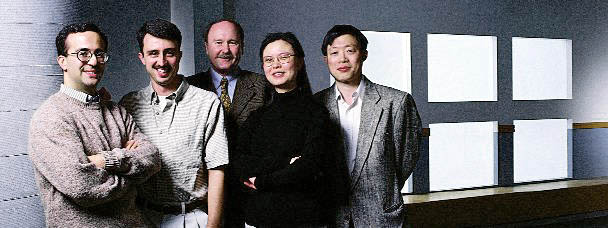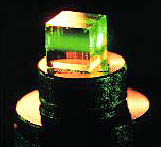EE at UCSCUCSC's electrical engineering program, which admitted its first class of undergraduates less than two years ago, is already on the threshold of becoming a full-fledged department, offering both undergraduate and graduate degree programs under the guidance of a faculty on the cutting edge of electrical engineering research.
Engineering a new department: UCSC's electrical engineering faculty are (l-r) Assistant Professor Ali Shakouri, Assistant Professor Peyman Milanfar, Professor and Department Chair John Vesecky, Associate Professor Claire Gu, and Associate Professor Jiayuan Fang. Photos by R.R. Jones Formal approval is expected from the UC Regents this summer for the Department of Electrical Engineering, making it the third department in UCSC's Jack Baskin School of Engineering along with computer science and computer engineering. Within the broad discipline of electrical engineering (EE), the new department is focusing on electronics, communications, and instrumentation and control systems. These areas were chosen to complement UCSC's existing strengths in computer-related fields, and they are also topics of great interest to industry, says Patrick Mantey, dean of the School of Engineering. "We are concentrating our faculty in areas we believe will be key to the future growth of industry in the Silicon Valley," Mantey says. Five EE faculty members have been recruited, including the chair of the new department, John Vesecky. The department's plans call for a total of ten faculty members by July 2000. Vesecky, who comes to UCSC from the University of Michigan's College of Engineering, said starting up a new department is a great opportunity. "My goal is to create a first-rate EE department and to complement the Computer Engineering and Computer Science Departments," Vesecky says.
"This open area is the living room for the engineering school," Mantey says. "We've created both formal and informal spaces for people to get together, to work in teams, and to rub shoulders with their colleagues." Optoelectronics is one area in which UCSC's EE faculty are engaged in exciting research. Optical fibers, which use light instead of electricity to carry data, are now widely used in communication systems because of their high speed and information capacity. Building on the success of fiber optics, researchers in optoelectronics are developing new technologies that take advantage of the unique properties of light for transmitting, processing, and storing information. "The next century will be the century of light," says Narinder Kapany, a fellow at AMP Incorporated in Palo Alto who has helped shape the optoelectronics program at UCSC. "There is a burgeoning need for optoelectronics research and development, and I believe UCSC will make significant contributions." Associate Professor Claire Gu and Assistant Professor Ali
Shakouri are both engaged in "Our goal is to build low-cost devices that can be used to extend fiber optics into people's homes," Gu says.
"We can transmit data at high speeds on optical fibers, but there is a bottleneck when you switch the signal from fiber to fiber, because currently the switching is done electronically," Shakouri says. Shakouri also is the technical director of a project to develop new ways of cooling increasingly powerful computer chips. The collaborative project, funded by the Defense Advanced Research Projects Agency, involves researchers from UCSC, UC Santa Barbara, UC Berkeley, Harvard University, and an industrial partner, HRL Laboratories. "As chips get smaller and faster, they generate a lot more heat. We are designing new cooling devices to integrate on top of the chips," Shakouri explains. Associate Professor Jiayuan Fang is addressing another set of problems associated with the increasing speed of computer chips. An expert in electromagnetics, Fang is working on ways to avoid the interference that results from coupling or "cross-talk" between different signals in integrated circuits and on circuit boards. "Problems with interference are more serious as micro-processor speeds get faster," says Fang, who joined the UCSC faculty in January. Peyman Milanfar, current-ly at SRI International in Menlo Park, will join the new department in the fall, bringing expertise in signal processing and image processing and enhancement. Vesecky's research, which involves the use of radar for remote sensing of ocean waves, currents, and winds, is conducted primarily on Monterey Bay and may lead to fruitful collaborations with researchers in marine sciences. Vesecky says he also sees opportunities for himself and other EE faculty to collaborate with researchers in astronomy. "One of the things UCSC is very good at is fostering work across disciplines," Mantey notes. --Tim Stephens |
|||||
Return to Summer '99 Issue Contents


